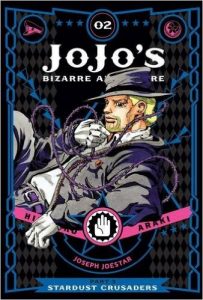By Hirohiko Araki. Released in Japan as “Jojo no Kimyou na Bouken” by Shueisha, serialized in the magazine Weekly Shonen Jump. Released in North America by Viz. Translated by Evan Galloway, original translation and adaptation by Alexis Kirsch and Mayumi Kobayashi.
For all of the cool fight scenes and new arrogant villains, there is a certain sameness to Stardust Crusaders that I just can’t seem to escape from. It doesn’t help that this arc of JoJo’s is essentially a road movie/extended chase scene, and so we don’t really get much plot beyond “who will turn up in which Middle Eastern town to attack our heroes?”. To be fair, some of those villains are interesting, and there’s a lot of “the villain thinks they will be saved by the main villain, but no, they are just another pawn” here, but I’ll tell you; reading Jotaro’s story is a lot like traveling across the Midwest and staying at the same Holiday Inn with the same wallpaper every single night. Fortunately, there is the art if nothing else; JoJo’s always LOOKS really cool.
As I’ve observed before, there is a huge love of Western music that we’ve seen throughout the series, particularly in the naming of its various characters (mostly villains, but let’s not forget R.E.O. Speedwagon too). It reminds me of a previous old-school manga Viz used to release back in the day, Bastard!!. And just like that series, some of the names have to be changed to avoid litigation. Here we have Enyaba on the cover, who is Enya with a -ba added to her name to let us know she’s a wizened granny. There is also Dan of Steel, who is named after Steely Dan, of course, and like the item the band named themselves after, he proves to be a giant dick. An enterprising young fan could probably give us a nice JoJo’s soundtrack filled with songs from the bands and artists mentioned here. It also helps to emphasize the ‘road’ feel of this storyline.
The fights are the same, filled with action and horror, also continuing the body possession from last time. Fortunately, there is also a helping of humor, some of it gross (Polnareff and his tendency to need to use the bathroom – which rebounds nastily on him here) and some of it amusing if a bit sad (Joseph was always street smart rather than intelligent, but a lot of times here he becomes stupid for the sake of the gag). The humor is needed to offset the grisliness of the battles here, with many of the villains being taken out in highly grotesque ways. For all that Dio is meant to be the main villain of this arc, and I’ve no doubt he will be appearing in the final volumes, so much of this is like a video game where you have to battle endless mid-boss after mid-boss. The journey here in JoJo’s is definitely more important than the destination, and therefore this volume gets the same opinion as the others: I liked it, but like the first two arcs better.



